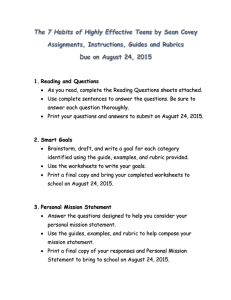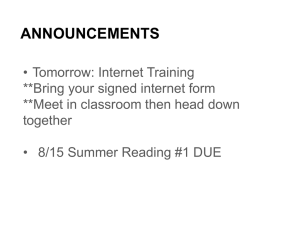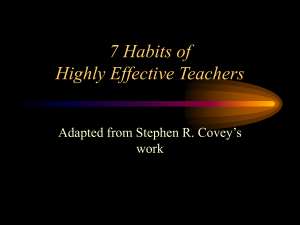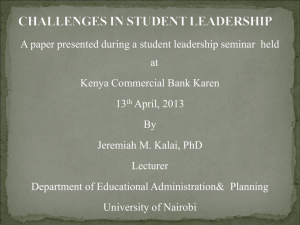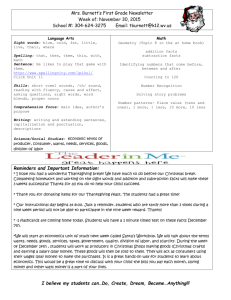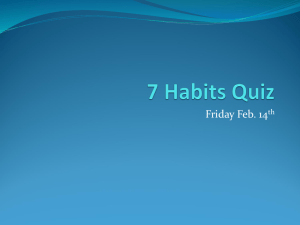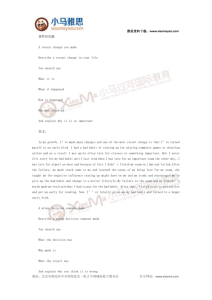Smart Goals - American Academy
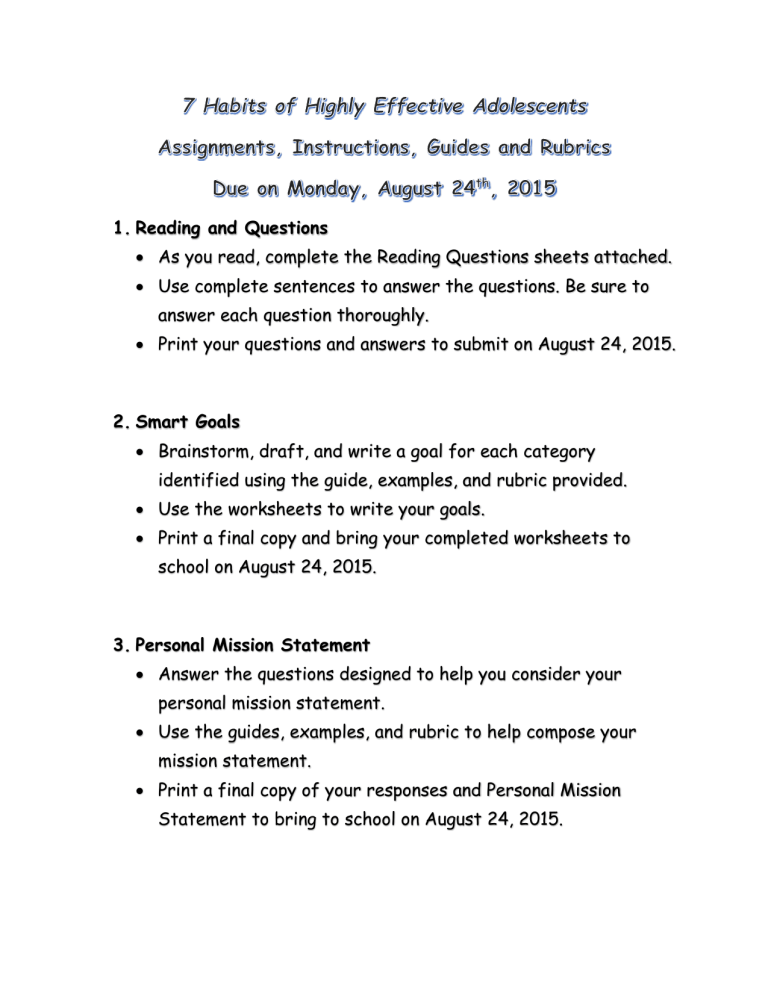
1.
Reading and Questions
As you read, complete the Reading Questions sheets attached.
Use complete sentences to answer the questions. Be sure to answer each question thoroughly.
Print your questions and answers to submit on August 24, 2015.
2.
Smart Goals
Brainstorm, draft, and write a goal for each category identified using the guide, examples, and rubric provided.
Use the worksheets to write your goals.
Print a final copy and bring your completed worksheets to school on August 24, 2015.
3.
Personal Mission Statement
Answer the questions designed to help you consider your personal mission statement.
Use the guides, examples, and rubric to help compose your mission statement.
Print a final copy of your responses and Personal Mission
Statement to bring to school on August 24, 2015.
The 7 Habits of Highly Effective Teens
Reading Questions
Instructions: Answer each part of each question using complete sentences.
Be specific, detailed, and direct in your responses.
1 2
Present but too vague or incomplete to understand
Written without using complete sentences
Lacking in sincerity, consideration, or thought
Suffering from spelling, grammar, and mechanical errors
Mostly incomplete
Reading Questions Rubric
Student responses are…
3 4 5
Somewhat vague and lacking in development
Mostly sentence fragments or otherwise incomplete sentences
Possibly lacking sincerity, consideration, or thought
Possibly suffering from spelling, grammar, and mechanical errors
Approximately halfway complete
6 7 8
Fairly accurate & thorough
Some complete sentences mixed in with fragments or otherwise incomplete sentences
Evident of some decisive and thoughtful work
Largely free of spelling, grammar, and mechanical errors
Mostly complete
9 10
Accurate and thorough
Mostly written using complete sentences
Sincere, in-depth, thoughtful, and decisive
Free of spelling, grammar, and mechanical errors
100% complete
Reading Questions
1.
What is the definition of each habit? o Habit One – Be Proactive: o Habit Two – Begin with the End in Mind: o Habit Three – Put First Things first: o Habit Four – Think Win-Win: o Habit Five – Seek First to Understand: o Habit Six - Synergize:
2.
What are the centers of life? Which one is the healthiest?
3.
What is the Personal Bank Account? o Relationship Bank Account? o What are examples of withdrawals and deposits for each? o Do you think this analogy (comparison) of human relationships to a bank is accurate or not, and why?
Habit 1: Be proactive
4.
What are examples of Circle of No Control and Circle of Control in your own life? Fill out the chart below with ideas.
Circle of No Control Circle of Control
5.
Explain the difference between reacting and responding by filling in this statement:
Reacting occurs when people _____________________; in contrast, responding occurs when people _____________________.
6.
Examine the chart below for language we use that is proactive (the speaker takes responsibility for his or her actions) or passive (the speaker does not take responsibility).
Some examples have been done for you. Add at least 3-5 more examples in each column.
Proactive Language (takes charge!)
I did not write assignments in my planner or check IC.
My homework is late because I am still learning to write my name first before I start working.
I did not use home room or class time to ask you about this assignment, so I did not finish it
Passive Language (passes responsibility)
I did not know this was due.
Class was so busy that it distracted me from putting my name on my work.
I did not understand this assignment, so I could not finish it. It was too confusing.
7.
What are the four human tools? What does each mean?
8.
What is one strategy from this habit you would like to build?
9.
How could the strategy identified in the question above improve someone’s life?
Habit 2: Begin with the End in Mind
10.
What is a mission statement?
11.
Why are mission statements important for individuals and organizations?
12.
What does S.M.A.R.T. stand for and what does each letter mean? o S: o M: o A: o R: o T:
13.
What does W.I.S.E. stand for and what does each letter mean? o W: o I: o S: o E:
14.
What is one short-term goal you have for yourself?
15.
What is one long-term goal you have for yourself?
Habit 3: Put First Things First
16.
What is most important to you in your life?
17.
What often keeps you from giving time to what’s most important?
18.
What is a paradigm?
19.
In the chart below, provide an example of an effective and an ineffective paradigm from your own life. An example has been provided for you.
Effective paradigms
I spend time on what’s most important.
Ineffective paradigms
I spend time on what’s most urgent.
Q1
Q3
20.
What are the four different time quadrants and what does each one mean? Fill in the answers in the chart below.
Q2
Q4
Habit 4: Think Win-Win
21.
What do the categories Win-Win, Lose-Win, Lose-Lose, and Win-Lose mean? Fill in the chart below with your answers.
Win-Win
Win-Lose
Lose-Lose
Lose-Win
22.
Into which category do you think you fall?
23.
Why do you think you fall into this category?
24.
How do you think this manifests in or affects your life?
25.
What is most beneficial about viewing life from a win-win perspective?
Habit 5: Seek First to Understand, then to be Understood
26.
During communication, there are three areas on which you should focus. What are they? o Area One: o Area Two: o Area Three:
27.
Of the five poor listening skills, clearly identify which one you think is the most destructive, give an example of it, and explain how it is so unhealthy. o Most destructive poor listening skill: o Example: o How does the example show that this poor listening tactic is unhealthy?
28.
What is Genuine Listening?
29.
What is one strategy from this Habit 5 that you might incorporate to improve your communication skills?
Habit 6: Synergy
30.
There are people who celebrate differences, have differences, and put up with differences. What are they called?
31.
What are the steps to the Synergy Action Plan?
32.
In reflection, which habit do you think is your strongest, and why?
33.
Which habit do you need to work on most, and why? (Consider targeting this for your personal Smart Goal.)
34.
What was the most helpful piece of learning or perspective that you gained from reading this book?
35.
What advice would you add to this book?
Setting Smart Goals
Goal setting is proactive and helps you begin with the end in mind.
Instructions: You will write three (3) measurable goals known as Smart Goals – two for Language Arts (reading and writing) and one personal goal. Fill out the Smart
Goal Worksheets attached to set your goals.
Smart Goals Rubric – Your goals should be…
1 2
Present
Extremely vague
Under-developed
No measurement method identified; too vague to be measured
3 4 5
Fairly important
Unclear; vague word choice makes ideas hard to understand
Lacking in development
No measurement method identified
6 7 8
Mostly important
Mostly clear & specific; word choice may be somewhat basic
Mostly developed
Measurement method present but may be somewhat ineffective
9 10
Extremely important
Very clear & specific; word choice is accurate and academic
Thoroughly developed
Measurable & method used highly effective
Example of a high-quality Language Arts Smart Goal:
Each week, I will accurately incorporate three (3) new, complex transitions words
or phrases into my writing for six (6) consecutive weeks until November 20, 2015.
Example of an unsatisfactory Language Arts Smart Goal:
I will improve my writing skills. – OR – I will have better punctuation.
Example of a high-quality personal Smart Goal:
Each day in home room, I will check to make sure that I have all necessary supplies and completed homework for all classes. I will arrive to all classes with paper, curriculum, pencil bag, and charged computer every day for 12 weeks with a 95%
success rate until November 20, 2015.
Example of an unsatisfactory personal Smart Goal:
I will be ready for class. – OR – I will have what I need.
Smart Goal Worksheet – Language Arts - READING
Language Arts Reading Goal Statement:
Why is this goal important?
Describe this goal using highly specific, accurate word choice:
How will you know if you have achieved this goal? What measurement method will you use? (Make
November 20, 2015 your end date; this is the last day of the first trimester.)
Predict and estimate what is needed to SMART Goal Checklist accomplish this goal.
Tasks:
Materials:
Time:
(Review your goal and check each one)
Is my goal…
Important? _____
Specific? _____
Achievable? _____
Measurable? _____
Time-Bound? _____
ACTION PLAN
Action Person Responsible Due Date
________________________ ___________________ __________
________________________ ___________________ __________
________________________ ___________________ __________
Smart Goal Worksheet – Language Arts - WRITING
Language Arts Writing Goal Statement:
Why is this goal important?
Describe this goal using highly specific, accurate word choice:
How will you know if you have achieved this goal? What measurement method will you use? (Make
November 20, 2015 your end date; this is the last day of the first trimester.)
Predict and estimate what is needed to SMART Goal Checklist accomplish this goal.
Tasks:
Materials:
Time:
(Review your goal and check each one)
Is my goal…
Important? _____
Specific? _____
Achievable? _____
Measurable? _____
Time-Bound? _____
ACTION PLAN
Action Person Responsible Due Date
________________________ ___________________ __________
________________________ ___________________ __________
________________________ ___________________ __________
Smart Goal Worksheet – Personal Goal
Personal Goal Statement:
Why is this goal important?
Describe this goal using highly specific, accurate word choice:
How will you know if you have achieved this goal? What measurement method will you use? (Make
November 20, 2015 your end date; this is the last day of the first trimester.)
Predict and estimate what is needed to SMART Goal Checklist accomplish this goal.
Tasks:
Materials:
Time:
(Review your goal and check each one)
Is my goal…
Important? _____
Specific? _____
Achievable? _____
Measurable? _____
Time-Bound? _____
ACTION PLAN
Action Person Responsible Due Date
________________________ ___________________ __________
________________________ ___________________ __________
________________________ ___________________ __________
Responses and Personal Mission Statement Rubric
1 2
Responses are vague to mostly missing
Personal Mission
Statement is present but highly under-developed; lacks genuine investment and effort
3 4 5
Responses are about halfway complete but may be inaccurate
Personal Mission
Statement lacks expression, goals, and development
6 7 8
Responses are mostly clear and accurate; mostly thorough and complete
Personal Mission
Statement is mostly expressive, goaloriented, and welldeveloped
9 10
Responses are clear and accurate; thorough and complete
Personal Mission
Statement is expressive, goaloriented, and welldeveloped
Generate ideas for your mission statement with brainstorming in the areas below.
A personal mission statement, as you have read about in the 7 Habits book, is a description of what you want to focus on, what you want to accomplish, and what you want to do in areas of your life, both personal and academic. A personal mission statement should include about 10-15 complete sentences, phrases, or ideas. Complete the following tasks to help you with creating this statement.
1.
Identify some talents that you have. Highlight words and phrases that describe you: accepting others cooking artistic creative thinking building things dancing athletic decision-making listening musical singing making things happen predicting speaking sensing things thinking ahead memorizing things sharing planning events work well with others mathematical scientific writing humorous reading running test-taking studying visual auditory
2.
Highlight some traits about yourself that might be included in your mission statement.
Positive Traits: accepting active adventurous alert assertive athletic balanced clever creative educated friendly healthy lively orderly calm committed daring enthusiastic funny helpful loving organized persistent pleasant selfless sensible sincere sociable careful competitive cautious charming cheerful dependable determined eager fair loyal genuine honest outgoing quiet sensitive considerate faithful gifted humorous independent kind musical passionate peaceful reliable serious soft-spoken strong cooperative flexible giving neat resourceful shy studious courageous easy-going forgiving happy optimistic persevering respectful silly stylish sympathetic tactful tolerant trustworthy talented unique thankful upbeat thoughtful tidy well-behaved wise
3.
Think of a person who has made a positive difference in your life (a parent, teacher, sibling, historical figure, leader, relative, friend, etc.). a.
Who is the person? b.
What qualities does that person have that you admire most?
4.
Twenty years from now…imagine that you are surrounded by the most important people in your life. Who are they and what are you doing? a.
Who is celebrating? b.
What you are doing:
5.
Fill in the the following chart to help identify your own personality and beliefs:
Prompts:
I am at my best when:
I am at my worst when:
I am at my worst when:
What do I really love to do in my personal time?
If I had unlimited time and resources, what would I choose to do, and why?
Possible life goals for me are:
I want to be a person who:
Your answers:
6.
What interests you? If you could be a specialist in any field you wanted, what would you study, and why? a.
Field you would study: b.
Why?
7.
What do you love to do? List three (3) things you love to do. It could be singing, dancing, drawing, reading, running, or even daydreaming.
8.
Five years from now, your local paper does a story about you, and they want to interview the people you mentioned as significant in your life. What would you want them to say about you? a.
Write words that you think they would use to describe you: b.
What do you hope to have accomplished?
9.
If you could spend an hour with any person who ever lived, who would that be? a.
Person you would pick, and why:
Personal Mission Statement
The information you’ve just written down is ready to compile into a first draft of your mission statement. Remember, this is a rough draft. Remove, rephrase, rewrite, and add thoughts or ideas that have meaning to you. Make it inspirational!
Here are a few sample mission statements to get you started. Read the samples, choose a method for writing your mission statement (see pages 90-91 for further help), draft, and then revise your mission statement in the final chart below.
Personal Mission Statement Samples
THE GOOD LIFE
Keep kindness and goodness in my heart
Live simply
Be happy for others
Replace worry with faith
Don’t waste energy on the what-ifs
Let go of things that hold me back
Keep my thoughts positive and believing
To strive honestly and joyfully to become the absolute best version of myself that is possible, while sharing all that I have to
Live like there is no tomorrow
Laugh every chance you get
Love everyone you meet
Learn from your mistakes
To use my creativity & positivity to better the lives of those around me and inspire others through a quiet and inner strength. offer with the world and people around me.
To laugh often and love much;
To win the respect of intelligent people
And the affection of children;
To earn the approbation of honest critics
And endure the betrayal of false friends;
To appreciate beauty;
To find the best in others; to give of oneself;
To leave the world a bit better,
Whether by a healthy child,
A garden patch,
Or a redeemed social condition;
To have played and laughed with enthusiasm
And sung with exultation;
To know even one life has breathed easier
Because you have lived –
This is to have succeeded.
Personal Mission Statement
Draft 1
Draft 2
Published Version
Some potential formats you could use for your mission statement:
“In ord er to … (what you want to achieve, do, or become) … so that (reasons why it is important). I will do this by … (specific behaviors or actions you can use to get there.)”
“I value… “choose one to three values because)… (reasons why these values are important to you.) Then
I will …(what you can do to live by these values.)”
“To live each day with… (choose one to three values or principles )… so that …( what living by these values will give you.) I will do this by…(specific behaviors you will use to live by these values.)”
“To be known by…(an important person/group)…as someone who is…(qualities you want to have )…by…(some other person/group)…as someone who is… (other qualities.)..
. “
